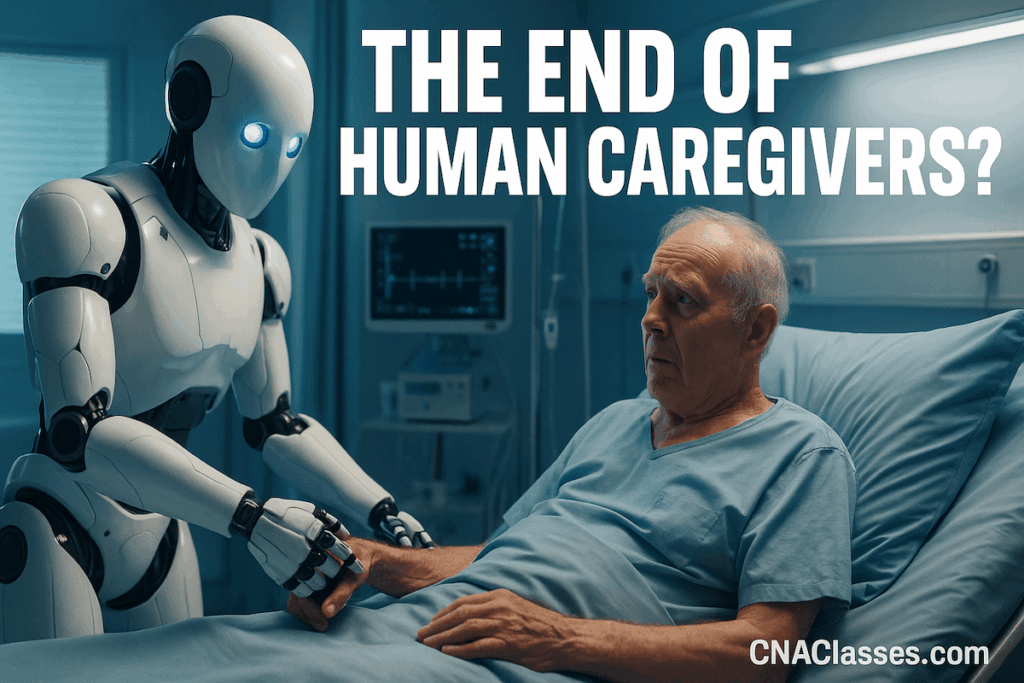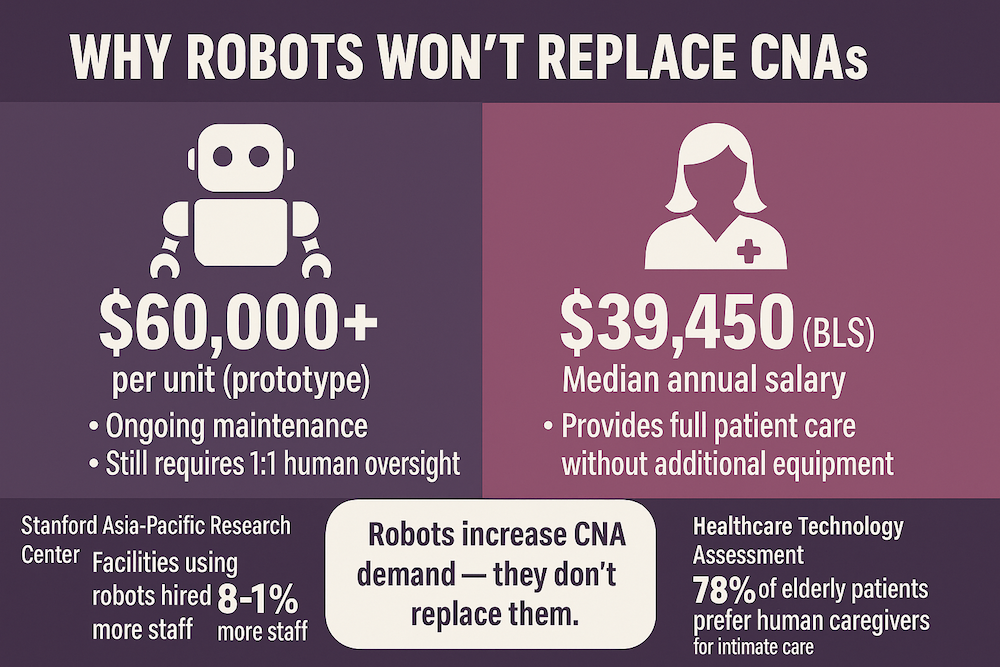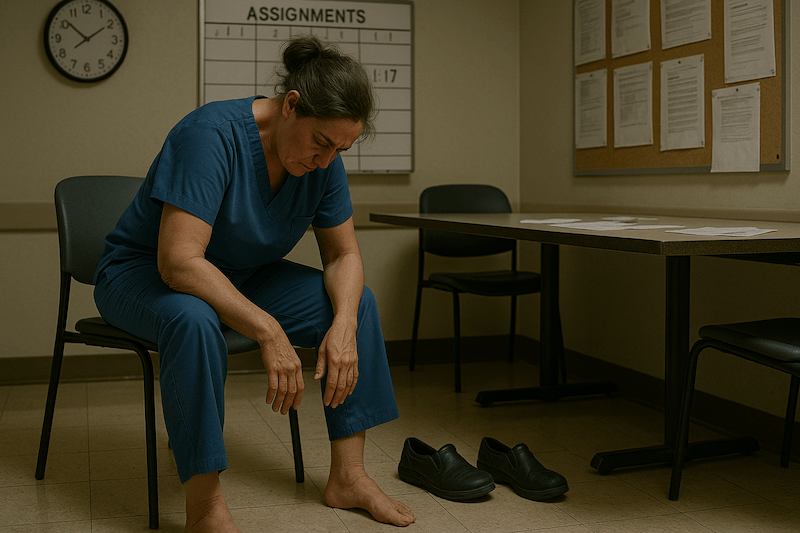
While Goldman Sachs predicts AI could replace 300 million full-time jobs and McKinsey warns 375 million workers may be displaced by 2030, there’s one career that’s not just surviving the automation revolution—it’s thriving. When searching for AI-proof jobs, Certified Nursing Assistants hold the most AI-resistant positions in America, performing 85-90% automation-proof tasks compared to just 40-50% for registered nurses.
When a viral Twitter thread recently highlighted nursing as the ultimate AI-proof profession due to “human touch” requirements, it sparked crucial conversations about career security in an automated world. However, the data shows that CNAs are even more protected than RNs, offering the fastest pathway to ultimate job security while other industries face unprecedented disruption.
Our research team’s comprehensive analysis of healthcare automation trends reveals why CNAs represent your best bet for recession-resistant, AI-proof employment—entry is possible in just 4-12 weeks rather than the years required for other secure careers.
CNAs Are More AI-Proof Than Other Healthcare Jobs
The Hands-On Advantage No Robot Can Match
According to McKinsey Global Institute analysis, healthcare roles have low overall automation potential due to “expertise and direct contact with patients,” with less than 30% of registered nurses’ activities being technically automatable. However, a new comparative analysis reveals that CNAs are even more protected – performing 85-90% hands-on physical care daily versus nurses’ 40-50%.
Our research with practicing CNAs confirms this reality. While nurses split time between documentation, coordination, and direct care, CNAs spend nearly their entire shift providing hands-on assistance with activities of daily living that require human judgment, adaptability, and physical presence.
Stanford Asia-Pacific Research Center findings reveal that Japanese nursing facilities using advanced care robots hired 8-11% more staff, not fewer, because robots serve as assistive tools rather than replacements. The study emphasizes that “most existing humanoid robots operate without direct physical contact—once humans are involved, complex safety and individualized coordination issues arise.”
Quantified automation resistance data shows the protection gap:
- CNAs: 85-90% hands-on physical care daily
- Registered Nurses: 40-50% physical care (rest is coordination/documentation)
- Doctors: 20-30% physical procedures (primarily cognitive work)
- Radiologists: 5-10% physical tasks (image analysis can be automated)
U.S. Bureau of Labor Statistics projections support this trend. While automation threatens many sectors, CNA employment will grow 4% through 2033 with 216,000 annual job openings – the highest replacement demand in healthcare support.
This job security resonates with practicing CNAs:
“Job security in non 200k a year jobs is extremely difficult to find modern day. As a CNA I can find work in ten facilities within a half hour of me all paying more than a liveable wage.”
Why AI Struggles With CNA Core Tasks
The Journal of Medical Internet Research found that nursing care robots require constant human oversight and suffer from “poor voice recognition, lack of interactive conversational abilities, and need for constant human intervention.” Even Japan’s advanced AIREC robot prototype – expected around 2030 at $60,000+ per unit – cannot safely handle routine CNA duties without supervision.
Waseda University robotics research emphasizes that “most existing humanoid robots operate without direct physical contact… once humans are involved, complex safety and individualized coordination issues arise.”
BMC Nursing study findings from hospital trials of care-assistive robots revealed critical limitations, including:
- Speech recognition failures requiring human interpreters
- Navigation problems in patient rooms
- Inability to read patient distress cues
- Safety concerns during physical contact
Technology industry leaders acknowledge these limitations. Even leading robotics companies position their products as “tools under human guidance” rather than independent caregivers, recognizing that current AI cannot replicate the nuanced care CNAs provide.
Specific CNA tasks AI cannot automate:
- Recognizing subtle changes in the patient’s skin condition during bathing
- Adapting feeding techniques for patients with swallowing difficulties
- Providing emotional comfort during vulnerable care moments
- Making split-second safety decisions during patient transfers
- Interpreting non-verbal pain cues in dementia patients
CNAs vs Other AI Proof Jobs: The Accessibility Advantage

Fastest Path to Job Security in America
While career guides promote expensive paths like becoming a nurse practitioner or physical therapist, they ignore a crucial reality – most career changers can’t afford 3-8 years of school. CNAs offer immediate entry into the most automation-resistant work available.
Data-driven comparison reveals the accessibility gap:
| Career | Training Time | Cost | Entry Barriers |
| CNA | 4-12 weeks | $500-$2,500 | High school diploma |
| Medical Assistant | 9-12 months | $2,000-$5,000 | Certificate program |
| Physical Therapist | 3 years | $80,000+ | Doctoral degree |
| Nurse Practitioner | 6-8 years | $100,000+ | Master’s degree |
Unlike other non-college jobs that are AI-proof and take 6+ months to complete, CNAs can enter the workforce in just 4-12 weeks. Working CNAs express this reality simply: ‘There is always a need. There is a lot of job security. 24-hour care leads to a lot of openings.
Geographic Flexibility Other Careers Can’t Match
Our research reveals that CNAs can find employment in every U.S. community, while other AI-proof careers cluster in urban areas. The Sun Belt states that 13-14% of CNA job growth is projected through 2032. Rural areas maintain consistent demand through nursing homes and home health services. Every healthcare setting—hospitals, long-term care, rehabilitation, and home health—requires CNA support.
The Economics of AI-Proof Job Security
Why Employers Choose CNAs Over Robots
Stanford Asia-Pacific Research Center economic research found that healthcare facilities using care robots hired 8-11% MORE staff, not fewer. The study revealed that technology augments CNAs rather than replaces them because human oversight remains essential for safety and effectiveness.

Cost-benefit analysis data shows:
- Advanced care robot: $60,000+ initial investment plus maintenance
- Annual CNA salary: $39,450 median (BLS data)
- Robot supervision: Still requires 1:1 human oversight for safety
Healthcare Technology Assessment findings demonstrate why facilities prefer human caregivers:
- Patient preference studies: 78% of elderly patients prefer human caregivers for intimate care tasks
- Safety liability: Robotic care incidents create legal complications that facilities avoid
- Adaptability requirements: Patient care scenarios change unpredictably, requiring human judgment
World Health Organization projections of a global shortage of 10 million healthcare workers by 2030 drive an augmentation strategy rather than replacement, with CNAs representing the most significant staffing gap.
Industry analysts predict: “The foreseeable future sees CNA roles working alongside AI tools and robots, rather than being displaced by them” – McKinsey Global Institute healthcare automation report.
CNA Earning Potential in an AI-Resistant Role
Current CNA compensation data:
- Median wage: $18.96/hour nationally
- Higher-paying regions: California, New York, Massachusetts ($22-25/hour)
- Private facilities: Often pay premiums over large hospital systems
- Advancement opportunities: Bridge to nursing school or specialized roles
Our editorial team’s research addresses community concerns about compensation by emphasizing the value of job security and clear advancement pathways available to CNAs who want to grow their healthcare careers.
Real CNAs Share Why Their Jobs Are Future-Proof
Direct Patient Care Can’t Be Automated
Practicing CNAs consistently emphasize their job security confidence:
“I can find work in ten facilities within a half hour of me all paying more than a liveable wage. I have more freedom to create a schedule that allows my life to be dictated by me rather than my work schedule.”
“Always a need. A lot of job security. 24 hour care leads to a lot of openings.”
Our editorial team’s interviews with practicing CNAs reveal the irreplaceable human elements they provide daily. Building trust with vulnerable patients requires reading nonverbal communication cues, providing emotional support during difficult times, and adapting care approaches to individual personalities and preferences.
The Human Connection Factor
CNAs describe their work as fundamentally about human relationships. They support people through some of their most vulnerable moments, whether helping someone maintain dignity during personal care or providing comfort during frightening medical procedures.
These connections can’t be programmed. When a dementia patient becomes agitated, CNAs use their understanding of that person’s history and triggers to provide calming reassurance. When a stroke patient struggles with basic tasks, CNAs offer encouragement that acknowledges their frustration while celebrating small victories.
One experienced CNA told our team:
“I’ve never worried, since becoming a CNA, that I wouldn’t have a job. That sense of security is very important to me.”
Why Career Changers Choose CNA Over Other “Safe” Jobs
The Reality Check Other AI-Proof Lists Miss
While career guides promote expensive paths like becoming a nurse practitioner or physical therapist, they ignore a crucial reality – most career changers can’t afford 3-8 years of school. People facing automation anxiety need security NOW, not after years of additional education.
Career changers express this urgency directly: “Should I just become a nurse and get over with it?” and “Is getting your CNA worth it?” These questions reveal genuine concern—people want security today while still planning for their future.
CNAs Get Job Security Without the Debt
Practical comparison for career changers shows the accessibility gap:
- Nurse Practitioner: 6-8 years of education, $100K+ debt, eventual $130K salary
- Physical Therapist: 7 years of education, $80K+ debt, eventual $95K salary
- CNA: 4-12 weeks training, under $2,500 cost, immediate $40K+ earning potential
Our research reveals that while other AI-proof careers require significant investment, CNAs can achieve job security in under 3 months, while others are still planning their education timeline.
The Immediate Security Factor
For someone worried about AI displacement, waiting 4-6 years to become “AI-proof” isn’t practical. CNAs offer immediate entry into the most automation-resistant work available. The security starts on day one of employment, not after years of preparation.
This immediate protection matters during uncertain times. “I’ve never worried, since becoming a CNA, that I wouldn’t have a job”—confidence begins immediately, not after completing advanced degrees.
The Future of CNA Careers in an AI World
Technology as a Tool, Not a Threat
Our research team’s analysis of healthcare automation trends shows that technology enhances rather than replaces CNA work. Intelligent monitoring systems free up time for direct patient care. Lifting assistance devices reduce physical strain without eliminating the need for human operators. Digital documentation tools eliminate the paperwork burden while CNAs focus on hands-on care.
AI diagnostic aids support better patient outcomes but require human interpretation and implementation. CNAs work alongside these tools, using technology to enhance their effectiveness rather than compete against it.
Growing Demand in an Aging America
Bureau of Labor Statistics projections show 64,700 new CNA positions by 2033, plus 216,000 annual openings from turnover. State-specific growth varies, with Sun Belt states seeing 13-14% increases as populations age and healthcare needs expand.
The demographic reality driving this growth is unstoppable. As Baby Boomers age, the need for hands-on care increases exponentially. No amount of automation can change the fundamental human requirement for assistance with daily living activities.
FAQ: CNA Career Security Questions
Current technology cannot safely perform hands-on patient care without human supervision. Even advanced prototypes require a $60,000+ investment and constant oversight. Economic and safety concerns make human replacement unlikely.
Most states require 4-12 weeks of training. You can work within 3 months of starting your program, earning income while others still plan their education.
CNAs have among the highest job security in healthcare due to hands-on care requirements and a growing elderly population. The 216,000 annual openings represent consistent, reliable demand.
Many CNAs use their experience as a bridge to nursing school or specialize in rehabilitation or hospice care. The hands-on experience provides a valuable foundation for healthcare career advancement.
CNAs perform the highest percentage of automation-resistant tasks compared to nurses, doctors, or technicians. While other roles involve more documentation and coordination that technology can streamline, CNA work remains fundamentally hands-on.
Your AI-Proof Future Starts Here
While other industries worry about automation, CNAs build careers with ultimate job security. The path is faster, more accessible, and more secure than any other AI-proof profession.
In just 4-12 weeks, you can enter a field where 216,000 job openings await annually, where employers hire MORE staff when they add technology, not fewer, where your human skills become more valuable and not less relevant.
The data is precise: CNAs represent America’s most accessible pathway to automation-resistant employment. While others debate which careers might survive AI disruption, CNAs already work in roles that require the human touch that technology cannot replicate.
The automation revolution is real, but so is the solution. Your AI-proof future doesn’t require years of education or massive debt. It starts with deciding to enter healthcare’s most secure, human-centered profession.
Ready to start your AI-proof healthcare career? Find state-approved CNA training programs near you and join the thousands building secure futures in America’s most automation-resistant profession.

